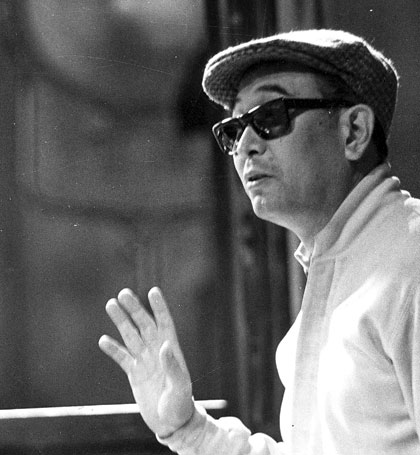 Name: Akira Kurosawa aka The Emperor
Name: Akira Kurosawa aka The Emperor
Essential DVDs: Ikiru (1952); Seven Samurai (1954); Throne Of Blood (1957); Yojimbo (1961); Sanjuro (1962); Ran (1985)
Oscars: Honorary Award (1990)
In His Own Words: “For me, filmmaking combines everything. That’s the reason I’ve made cinema my life’s work. In films painting and literature, theatre and music come together. But a film is still a film.”
Strip away the literary fabric that now shrouds the works of Akira Kurosawa, delve beneath the Japanese costume and external architecture, and you will discover the throbbing heartbeat of the Everyman. His canon is neither esoteric nor arcane, simply a collection of works that explores universal themes: man’s labour for fulfillment; the necessity for humane action in the tornado of an oppressive world; that world’s propensity to disguise the truth beneath a veneer of deception. In fact Kurosawa has often been credited with reflecting an image of his native culture that Westerners can easily grasp; he made films that seem intrinsically Japanese, yet prove universally popular.
Significantly, while Kurosawa set out to reinvigorate a Japanese cinema subdued by defeat in WWII, the filmmaker himself drew much inspiration from the West. He trained as a painter in a Western art school, absorbing a love of non-Occidental literature and film as well as painting, dipping into this treasure trove throughout his career. He wove tales with the threads of Shakespeare (Hamlet in The Bad Sleep Well; Macbeth in Throne Of Blood), Dostoyevsky (The Idiot) and Gorki (The Lower Depth), while the genius of John Ford shone through the sweeping, painterly compositions of his epic period films.
Indeed, it was his visual inventiveness, perhaps above everything else, that cemented Kurosawa’s reputation, inspiring slavish remakes of his films (from 1957’s Magnificent Seven right up to last year’s King Arthur) and a list of fans that includes the cream of modern moviemakers, many of whom are featured within these covers, all drawn to the banner he thrust into the ground with his most famous film, Seven Samurai. All Kurosawa’s movies showcase the director’s dazzling technical artistry, but it is those that spin round the vortex of action which benefit most. Where better than the field of conflict to contrast benign judgements with malign, to offset social chaos with humane actions? Matching his style to his content, Seven Samurai remains the Kurosawa masterpiece, whipping up bold effects and contrasting moments – intense wind and rain, violent wipes to join the scenes, fast-tracking shots, montages of action, all hewn from a creative temperament that that embraced the unorthodox. He near perfected his much-loved bloody, violent montage.
Sift through the history of Japanese cinema and Kurosawa’s lustre may fade when compared to earlier filmmakers Yasujiro Ozu, Kenji Mizoguchi and Teinosuke Kinogasa, but without Kurosawa their work would not have found such a fertile audience in the West. Akira Kurosawa was a giant among Japanese filmmakers, both literally and metaphorically. Standing at almost six feet tall, he towered over most of his national peers; it is fitting that his action movies still tower over the innumerable imitators that have followed in their wake.
